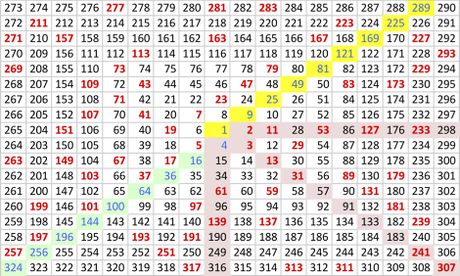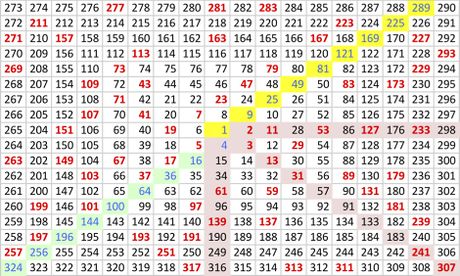How to Create a Spirallic Numbers Dataset
Part 1 of 3:
The Tutorial
-

- Make the dataset by opening a new Excel worksheet and choosing a cell inwards and downwards about 10 rows and columns to start inputting the numbers into. You may start with 0 or 1 or any number; 1 is recommended.
- Proceed sequentially outwards in a spiral. If you want to save a little time, use a formula like "=J15+1" and copy it up, across or down off as many cells as need be. You may then find a like formula nearby as you go outwards, which will speed things up greatly. This will also allow you to use any originating number in the center, should you so choose..
- After you have built the data set up to 100 or 324 (as in the example), you're good to go!
- You will notice right away that the prime numbers are fairly evenly distributed in the 4 quadrants at this point. You might try blocking in non-primes in groups in patterns to see if you can predict primes!
- Notice there are a number of sequences to the columns and numbers which follow Summation Notation.
- Notice also that the first sequence is easy -- it's the diagonal from the center to the bottom right. Its pattern to produce the sequence 1,3,13,31,57,91,133,183,241,307, ... is -1*0+1=1, 1*2+1=3, 3*4+1 =13, 5*6+1 = 31, etc. You will find a similar pattern extending to the upper left.
- Notice that the second pattern is trickier: the vertical pattern that produces the sequence 1,4,15,34,61,96,139,190,249,316 is more involved. If one takes the difference of those numbers and then the differences of the differences, one gets 8's, so one knows that a constant value of 8 is being added in the sequence. Knowing that, a typical rate of change is produced by ((a*b)+c)+8 = result, with a being constant. Such is the case here as it turns out, for the sequence is produced by ((4*-2)+4+8)=4, ((4*1)+3+8)=15, ((4*6)+2+8)=34, ((4*13)+1+8) = 61, etc. with the increment to b being 3,5,7,... and the increment to c being -1, while a=4 and 8 are constants. There's an elegant way to write that in Summation Notation with N's and K's and i's and all but it's beyond the text capacity we're operating under. Actually, I just found another way to resolve the series: 1==((-1*0)-7)+8, 4=((1*2)-6)+8, 15=((3*4)-5)+8, 34=((5*6)-4)+8, 61=((7*8)-3)+8, 96=((9*10)-2)+8, etc.
- Notice the horizontal pattern is a bit trickier to discover. 8's were again a constant difference of the differences but it took me awhile to find the rest of the formula. The sequence of 11,28,53,86,127,176,233,298, ... is generated as far as I know by ((4*-5)+23)+8=11, ((4*-1)+24)+8 = 28, ((4*5)+25)+8 = 53, ((4*13)+26)+8 = 86, etc., with a=4 and 8 remaining constant while b increments by 4, 6, 8,... and c incrementing by 1. Again, there's a more elegant way to state that. If anyone happening to read this can help out, great. There's another way to resolve this sequence also: 2=((2*3)-12)+8, 11=((4*5)-17)+8, 28=((6*7)-22)+8, 53=((8*9)-27)+8, 86=((10*11)-32)+8, 127=((12*13)-37)+8, 176=((14*15)-42)+8, 233=((16*17)-47)+8, and 298 =((18*19)-52)+8, etc. with element c decrementing by -5 each time.
- Notice that the diagonals take the form of ((a*b)+c)+d = Sum wherein b_sub_0 is 1 greater than a_sub_zero, a_sub_1 was 2 greater than a_sub_0 and b_sub_1 was 2 greater than b_sub_0, i.e. (1*2) changed next to (3*4). This might be the general pattern instead of working with 4's as had been, The role of d=8, the difference of the differences, was still present, so then you just need to figure out which a and b pair best approximated the answer and adjust with c accordingly, by trial and error. It did not take long to hit upon the solutions.
- There are resolved 2 more sequences: 5=((2*3)-9)+8, 18=((4*5)-10)+8, 39=((6*7)-11)+8, etc. and also 8==((2*3)-6)+8, 23=((4*5)-5)+8, 46=((6*7)-4)+8, 77=((8*9)-3)+8, 116=((10*11)-2)+8,163=((12*13)-1)+8, 218=((14*15)-0)+8 and 281=((16*17)+1)+8. These were done by the analytical method described above in Step 9, though it's a good hunch the problem will only yield to greater finesse than the lazy mathematician possesses.
Part 2 of 3:
Explanatory Charts, Diagrams, Photos
-
 Review the spirallic dataset again to see if you can spot any other sequences in it -- how about the Fibonacci Series? Has anyone hi-lited that yet? Might be interesting!#
Review the spirallic dataset again to see if you can spot any other sequences in it -- how about the Fibonacci Series? Has anyone hi-lited that yet? Might be interesting!#
Part 3 of 3:
Helpful Guidance
- Make use of helper articles when proceeding through this tutorial:
- See the article How to Datamine for Primes Using a Spirallic Dataset for a list of articles related to Excel, Geometric and/or Trigonometric Art, Charting/Diagramming and Algebraic Formulation.
- For more art charts and graphs, you might also want to click on Category:Microsoft Excel Imagery, Category:Mathematics, Category:Spreadsheets or Category:Graphics to view many Excel worksheets and charts where Trigonometry, Geometry and Calculus have been turned into Art, or simply click on the category as appears in the upper right white portion of this page, or at the bottom left of the page.
4.1 ★ | 7 Vote
You should read it
- SEQUENCE in SQL
- Fibonacci series in Data Structures and Algorithms
- How to change Facebook Fanpage catalog
- 50+ Very beautiful pattern tattoos
- How to Reset Lock Pattern on Android Tablet
- The unique lock screen pattern, hegemony
- How to Use the Mirror and Pattern Tools in Siemens NX
- Synthetic beautiful pattern background
May be interested
- How to use formulas and functions in Numbers on Mac
 do you use numbers on mac to track, log, manipulate, and analyze data? whether you know it or not, this app provides some built-in tools for better data processing.
do you use numbers on mac to track, log, manipulate, and analyze data? whether you know it or not, this app provides some built-in tools for better data processing. - How to insert page numbers in Excel
 page numbering in excel differs from page numbering in word, we will need to customize the page setup group in excel.
page numbering in excel differs from page numbering in word, we will need to customize the page setup group in excel. - How to add page numbers on Google Docs
 adding the number of pages on google docs will make it easier for users to manage their documents.
adding the number of pages on google docs will make it easier for users to manage their documents. - How to circle numbers in Word
 create a circled number in word to make your text presentation even more beautiful and special. to be able to circle numbers in word, follow these steps. first you need to go to the insert ribbon, located right next to home on the word toolbar.
create a circled number in word to make your text presentation even more beautiful and special. to be able to circle numbers in word, follow these steps. first you need to go to the insert ribbon, located right next to home on the word toolbar. - Draw the guy wearing a cowboy hat with numbers from 1 - 10 exciting poles
 a short video with the title of a picture created from 10 numbers was posted on the photo sharing platform gfycat recorded the process of drawing the guy wearing a cowboy hat with numbers from 1 to 10 in just 15s making the people live enjoy it.
a short video with the title of a picture created from 10 numbers was posted on the photo sharing platform gfycat recorded the process of drawing the guy wearing a cowboy hat with numbers from 1 to 10 in just 15s making the people live enjoy it. - Official information about the number of SIM 11 transfers is about 10 numbers of carriers
 the department of telecommunications - ministry of information and communications has recently issued an official letter on the process of converting from 11 numbers to 10 numbers (the time and new subscriber numbers for each operator) will officially begin. from september 19 here.
the department of telecommunications - ministry of information and communications has recently issued an official letter on the process of converting from 11 numbers to 10 numbers (the time and new subscriber numbers for each operator) will officially begin. from september 19 here. - How to create a phone number can be called on Google Sheets
 google sheets has a call feature when entering phone numbers into data tables, via callers installed on the computer.
google sheets has a call feature when entering phone numbers into data tables, via callers installed on the computer. - Instructions to change phone numbers associated with home banking
 currently, some banks have sent notices and support methods for you to update your phone number at home such as message confirmation, conversion via website system, applications, ...
currently, some banks have sent notices and support methods for you to update your phone number at home such as message confirmation, conversion via website system, applications, ... - Zalo, Viber will automatically convert the subscription number from 11 numbers to 10 numbers
 users of zalo and viber will be supported to continue using the service completely automatically when the time of sim 11 to 10 numbers is implemented starting from 00:00 on september 15, 2018 instead of having to be updated again. phone number manually.
users of zalo and viber will be supported to continue using the service completely automatically when the time of sim 11 to 10 numbers is implemented starting from 00:00 on september 15, 2018 instead of having to be updated again. phone number manually. - PERCENTRANK.INC function - The function returns the rank of a value in a dataset as a percentage including values 0 and 1 in Excel
 percentrank.inc function: the function returns the rank of a value in a dataset as a percentage including values 0 and 1. the function supports excel 2010 and later versions. syntax: percentrank.inc (array, x, [significance])
percentrank.inc function: the function returns the rank of a value in a dataset as a percentage including values 0 and 1. the function supports excel 2010 and later versions. syntax: percentrank.inc (array, x, [significance])












 How to Search in Google Sheets on iPhone or iPad
How to Search in Google Sheets on iPhone or iPad How to Hide Rows on Google Sheets on PC or Mac
How to Hide Rows on Google Sheets on PC or Mac How to Make a Finance Spreadsheet
How to Make a Finance Spreadsheet How to Create an Excel Spreadsheet Without Excel
How to Create an Excel Spreadsheet Without Excel How to Do Cost Volume Profit Analysis
How to Do Cost Volume Profit Analysis How to Refer to Tables and Figures in a Text
How to Refer to Tables and Figures in a Text